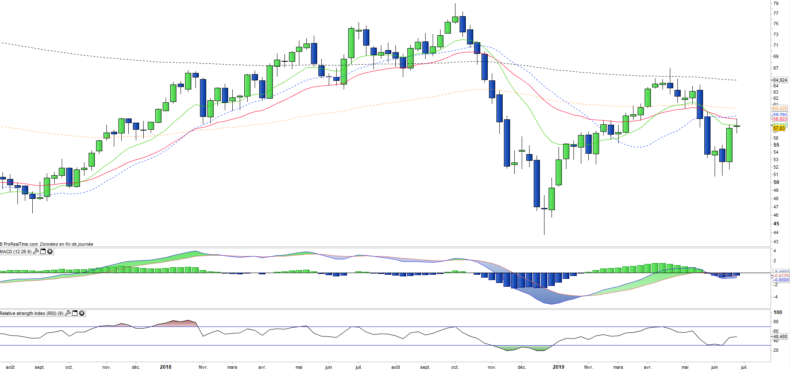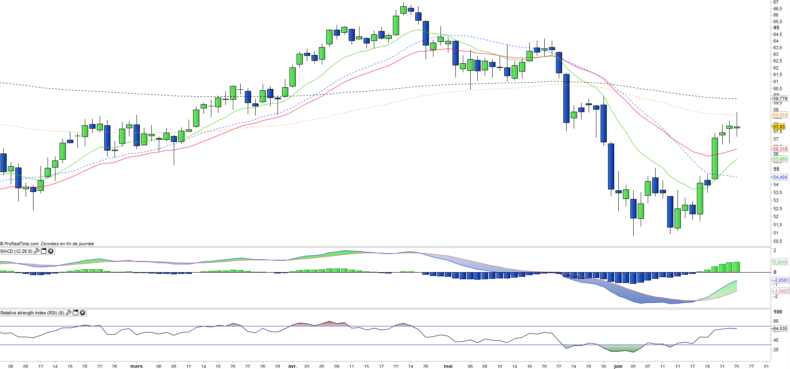Oil WTI - CLXXXX - 26/06/19
Short Term trend: Negative (20/100)
Long Term trend: Negative (0/100)
(scores computed by our proprietary algorithms - cf methodology)
to access to our Buy / Sell signals
on ETFs and Stocks
Profile
Oil is a raw material that is a fossil fuel produced by a few countries like Saudi Arabia, the US, Russia, Iran, Iraq, Algeria or Nigeria.
It is extracted by drilling or hydraulic fracturing and is then delivered - processed / refined or not, in consumer countries, mainly European and Asian and can produce fuels such as gasoline, gas oil or kerosene once refined and processed chemically.
Depending on its origin and final destination, oil has different names and its price may also vary. These differences in the price of oil depend on its quality. We differentiate the Arabian Light, which comes from the Middle East, the Brent oil that is produced in the North Sea, and finally the WTI or "West Texas Intermediate" which is produced in the United States and is the benchmark of the oil market.
The reference unit for oil is the barrel, which is actually about 159 liters. The price of a barrel of oil is quoted on the international market continuously, while two financial centers share its rating, namely New York for WTI and London for Brent. Supply, therefore production and its stability are of course key determinants of the price of a barrel.
It is OPEC, made up of several major world producing countries, which is in charge of determining - by consensus - how many barrels a day will be produced and its publications are therefore followed with attention by traders, as was the case recently. Demand factors are also critical. Thus, an increase in the energy needs of a major consumer country may have a greater or lesser influence on the price of the barrel.
Globally, global growth is a very important factor for demand, while oil needs tend to shrink at equal demand, as new technologies tend to reduce consumption.
In the long term, the electric car could cause a negative shock on global demand for crude oil, as China is investing heavily in renewable energy.
Since 2014, oil prices have divided by 3 due to a supply shock caused by the arrival on the market of American shale oil which has put very strong pressure on the oil-producing and oil companies that have significantly reduced their investments. This stoppage of industrial investment, in addition to OPEC's production cuts, has for the moment had a moderate bullish impact on crude prices. This is due to the plethoric production of unconventional oil (shale) that floods the market and counterbalances OPEC's reduction efforts. WTI oil rebounded by 23% since the beginning of the year but turned violent in May after the failure of negotiations between China and the US.
The current moderate rebound is a re-creation of a geopolitical premium because of growing tensions between the US and Iran that could lead to military conflict in the event of a slippage of one party or another. Doubts about global demand remain a powerful downward catalyst.
Technical analysis
Weekly data analysis
The weekly chart shows an ongoing rebound to moving averages that are concentrated around $ 60. It is an impulsive rebound within a downtrend and not a bullish reversal. Oil is returning to a wait-and-see attitude with an axis of symmetry around $ 60, waiting for catalysts, which can be bullish as well as bearish, to emerge. Oil is therefore waiting for a direction and volatility could suddenly increase.
Daily data analysis
On the daily chart, we can see a rebound that allows the index to return to its EMA100 and erase part of May's decline without relaunching the uptrend. Oil prices are caught between major risks on supply and at the same time on demand, which explains the lack of direction in the short term. This hesitation could give way to a more directional phase in the coming weeks depending on the evolution of the situation with Iran and China in particular.


